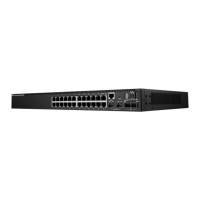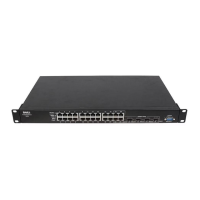OSPF Commands 737
area virtual-link authentication
Use the area virtual-link authentication command in Router OSPF Configuration mode to
configure the authentication type and key for the OSPF virtual interface identified by the area
ID and neighbor ID. Use the no form of the command to return the authentication type to the
default value.
Syntax
area
area-id
virtual-link
neighbor-id
authentication {none | simple
key
|encrypt
key
key-id
}
no area
area-id
virtual-link
neighbor-id
authentication
•
area-id
— Identifies the OSPF area to configure. (Range: IP address or decimal from
0–4294967295)
•
neighbor-id
— Identifies the Router identifier of the neighbor.
• encrypt — Use MD5 Encryption for an OSPF Virtual Link.
•
key
— Authentication key for the specified interface. (Range: 8 bytes or less if the
authentication type is simple and 16 bytes or less if the type is encrypt.)
•
key-id
— Authentication key identifier for the authentication type encrypt. (Range: 0–255)
Default Configuration
This command has no default configuration.
Command Mode
Router OSPF Configuration mode.
User Guidelines
Unauthenticated interfaces do not need an authentication key.
Example
The following example configures the authentication type and key for the area 10 OSPF virtual
interface and neighbor ID.
console(config-router)#area 10 virtual-link 192.168.2.2
authentication encrypt test123 100
area virtual-link dead-interval
Use the area virtual-link dead-interval command in Router OSPF Configuration mode to
configure the dead interval for the OSPF virtual interface on the virtual interface identified by
area-id and neighbor router. Use the no form of the command to return the dead interval to the
default value.

